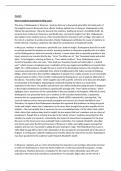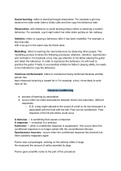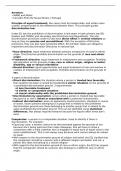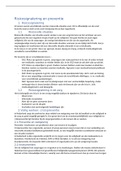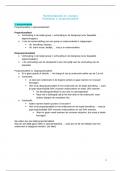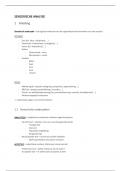History Revision – Paper 2
ITALIAN UNIFICATION
The old order was restored across the Italian peninsula in 1815 by the terms of the Treaty of Vienna
Reactionary rule was to be guaranteed by the military might of Austria but the legacy of Napoleone
rule was nor entirely lost. Those who wished for individual liberty, guaranteed rights, administrative
efficiency and constitutional government were, from time to time, prepared to challenge the restored
regimes through revolt and revolution. But such challenges were neither co-ordinated nor did they
take place on a national scale.
The desire to create a nation state - L'Italia - was not widespread and the short-term impact of Young
Italy, an organisation founded by Giuseppe Mazzini in 1831, was not significant. However, Young
Italy, and to a lesser extent other secret societies, sowed the seeds of the idea of an Italian nation
state based on democracy and popular consent. The progress of such an idea was limited because it
represented a threat to the established order. Similarly, the popular appeal of revolutionary
nationalism in the 1830s and 1840s was not great because it did not address the more fundamental
issues of land ownership and day-to-day subsistence. In the 1840s, writers such as Cesare Balbo,
Massimo d'Azeglio and Vicenzo Gioberti proposed more conservative suggestions for the
development of the cause of national unity. However, there was no consensus as to the ideal nature of
or shape of an Italian state or how it might be achieved.
The Risorgimento was a cultural phenomenon centring on the concept of a national reawakening.
Such an idea was expressed through literature, music, academic meetings and journals. The impact of
the ideas of the Risorgimento was limited although there was a growing awareness of such ideas was
among the literate classes between the restoration in 1815 and 1848. The unifying factor for most
Italian nationalists were the desire to challenge Austrian influence and expel the Austrians from the
Italian peninsula. Revolution broke out in many Italian states in 1848. Liberal constitutions were
granted, and, in some states, republics proclaimed. The revolutions failed because of regional
differences, diversity of aims and the lack of foreign support. Ultimately, they failed because of the
military might of Austria with conservative rule prevailing.
POLITICAL GEOGRAPHY
The treaty of Vienna restored the borders of a patchwork of Italian states after the disruption of the
Napoleonic wars. There was no uniformity to the political geography of these states, each having its
own district culture of government.
The kingdom of Sardinia [Piedmont]
o Made up of piedmont on the mainland and island of Sardinia, the house of Savoy ruled this
relatively poor part of Italy. Sardinia was particularly backward and sparsely populated.
Despite its poverty, successive rulers built a strong army and governed with an effective civil
service. The treaty of Vienna recognised the House of Savoy as the rightful rules of Piedmont.
In 1814, Victor Emmanuel I returned to Piedmont and immediately began to restore the
absolutist state. The code Napolean was repealed, as were various rights such as free open
trials and church was restored to its pre Napoleonic status.
,Lombardy:
o Before the Napoleonic Wars, Lombardy had been part of the Austrian Empire. Its capital,
Milan, was the second largest city of that empire. Lombardy was ruled by Austrian officials
who acted in the name of the Austrian emperor. However, they were given a fair degree of
freedom to act as they saw fit with the Austrian army underpinning imperial rule. It
maintained a number of military strongholds known as the Quadrilateral, which dominated
the plain of the fertile Po Valley. The Napoleonic conquest of Lombardy was a mere
interlude, Lombardy was returned to Austrian control in 1814.
The Papal States:
o Stretching from the cities of Ferrara and Bologna in the north down to Benevento in the south,
the Papal States (Umbria, The Marches and Romagna) dominated central Italy. They were
ruled by the head of the Catholic Church, who resided in Rome. The pope was not just a
spiritual leader, he also had temporal power. To most popes, control of the Papal States was
considered essential to the protection of papal independence.
o However, the pope did not have a significant army and relied on Catholic countries to protect
them militarily if required. Founded in the 16th century in response to the Protestant
reformation, the Society of Jesus (otherwise known as the Jesuits) became the theological
shock' troops of the Catholic Church. This meant that they would act to promote Catholicism
wherever it was under threat. The Jesuits were the archenemies of those who opposed the
power and influence of the Catholic Church. Between 1805 and 1808, Napoleon's armies took
over different parts of the Papal States. Then, in 1809, Napoleon declared that Rome was to
be the "Second City of the Empire', that is, it would be incorporated into the French Empire.
Pope Pius VII was to become a prisoner. By the terms of the Treaty of Vienna, Pope Pius VII
was restored to his position as spiritual and temporal ruler of the Papal States.
o The Code Napoleon was abolished in most parts of the Papal States and the papal legal codes
re-established. However, such a move was not universal. In Romagna the Code Napoleon
remained. Austrian influence over the region was considerably increased by the fact that
Austrian armed forces were to be stationed in the Papal States.
Venice:
o Otherwise known as the Republic of St Mark, this had been a powerful independent state in
the 15th and 16th centuries because its merchants dominated trade in the Mediterranean. By
the 1790s, the republic had lost its importance as a trading power, although not its
architectural. From 1805 Venice was annexed by Austria.
The Central Duchies:
o This term refers to the independent states of Tuscany, Modena and Parma. Tuscany had been
governed by part of the Habsburg family, the House of Lorraine, since the 1730s. Relatively
prosperous, Tuscany had been at the heart of the Renaissance from the 14th to the 16th
centuries. During the Napoleonic period the Central Duchies were amalgamated in 1801 into
the Kingdom of Etruria, which was eventually annexed by France. The Treaty of Vienna left
the Central Duchies firmly under Austrian influence. Grand Duke Ferdinand Ill, brother of the
Austrian Emperor became ruler of Tuscany. However, this did not mean that he was as
conservative or as repressive as some of the other restoration rulers. Indeed, Ferdinand and
his first minister, Victor Fossombroni, improved education, set up hospitals and food relief
during the outbreak of typhus in 1815-16, and allowed freedom of expression, which was not
permitted in the rest of Italy.
Modena and Parma
, o were separated from Tuscany by the Apennine Mountains. These two states had a certain
political independence although, like Tuscany, they were within the sphere of Austrian
influence. The new ruler of Parma post-Vienna, Marie Louise of Bourbon-Parma, was equally
broad-minded. She repealed the Code Napoleon in 1820, but replaced it with something
similar. This was no surprise given the fact that she had been Napoleon's wife! In Modena,
Duke Francis IV was far more repressive, reinstating the Jesuit order's influence over the lives
of the Modenese.
The Kingdom of Naples:
o This kingdom was made up of Sicily and the southern part of mainland Italy. Ruled by the
Bourbon family, the Kingdom of Naples was the poorest region of Italy. In 1847, the writer
Luigi Settembrini wrote of it. 'No state in Europe is in a worse condition than ours .. In the
country that Is said to be the garden of Europe, the people die of hunger and are in a state
worse than beasts: The kingdom was dominated by Naples, the largest city in Italy at the end
of the 18th century with a population of 400k. However, most of the population of Naples and
indeed the whole kingdom, lived in desperate poverty.
Rumblings of discontent
Although in the 1820a there were no national movements pressing for Italian unity, there were groups
with serious grievances against the type of rule re-introduced in 1815, some of the discontent joined
secret societies such as the Carbonari. Those who had lost out from the restoration of the old
monarchies like civil servants were keen on radical action.
Uprisings and revolutions in 1820-21 in Naples, Sicily and Piedmont reflected dissatisfaction with
several rulers. But this satisfaction was usually related to local issues. The revolutions that took place
were to challenge the legitimacy and rule of some of the restored rulers. However, they did not go as
far as to challenge the Austrian hegemony, nor did they form the basis of a movement demanding
change on a national basis.
The failures of the 1830-32 revolutions
⇒ Modena
In 1831, Misley an academic, Italian patriot and leading member of the Carbonari led an uprising in
Modena as well as a friend of the Duke of Modena, who he tried to enlist the support of the Duke with
a return for a promise to support him in a bid to become King of Italy, seemed interested, but was
aware of the dangers in challenging Austrian power. With revolution spreading Duke fled to Vienna
to plead support from Metternich. Revolutionary excitement did not last long. In March 1831, Duke
returned to the Central Duchies with an Austrian army and the revolutionaries were crushed.
⇒ The revolution in the Papal states
Much more threatening to the established order in Italy was the outbreak of revolution in 1831 in the
Papal States. The Papal States had not been touched by the 1821 revolutions, but liberals were
repressed, and the secret societies were weaker than they were further south in Naples. In February
1831, a reactionary Church leader, Cardinal Cappellari, was elected Pope Gregory XVI.
As revolution raged in Modena and Parma, so one of its leading conspirators, Menotti, urged an
uprising in the Papal States. But those in the Papal States who responded to the rallying cry for
revolution were not, on the whole, nationalists but liberals who wished to challenge the clerical state
and to re-establish a secular state similar to that under Napoleonic rule. In February 1831, a
revolutionary army led by Colonel Giuseppe Sercognani captured the papal port of Ancona and the
Umbrian capital Perugia. The following month a provisional government led by the elderly Giovanni
ITALIAN UNIFICATION
The old order was restored across the Italian peninsula in 1815 by the terms of the Treaty of Vienna
Reactionary rule was to be guaranteed by the military might of Austria but the legacy of Napoleone
rule was nor entirely lost. Those who wished for individual liberty, guaranteed rights, administrative
efficiency and constitutional government were, from time to time, prepared to challenge the restored
regimes through revolt and revolution. But such challenges were neither co-ordinated nor did they
take place on a national scale.
The desire to create a nation state - L'Italia - was not widespread and the short-term impact of Young
Italy, an organisation founded by Giuseppe Mazzini in 1831, was not significant. However, Young
Italy, and to a lesser extent other secret societies, sowed the seeds of the idea of an Italian nation
state based on democracy and popular consent. The progress of such an idea was limited because it
represented a threat to the established order. Similarly, the popular appeal of revolutionary
nationalism in the 1830s and 1840s was not great because it did not address the more fundamental
issues of land ownership and day-to-day subsistence. In the 1840s, writers such as Cesare Balbo,
Massimo d'Azeglio and Vicenzo Gioberti proposed more conservative suggestions for the
development of the cause of national unity. However, there was no consensus as to the ideal nature of
or shape of an Italian state or how it might be achieved.
The Risorgimento was a cultural phenomenon centring on the concept of a national reawakening.
Such an idea was expressed through literature, music, academic meetings and journals. The impact of
the ideas of the Risorgimento was limited although there was a growing awareness of such ideas was
among the literate classes between the restoration in 1815 and 1848. The unifying factor for most
Italian nationalists were the desire to challenge Austrian influence and expel the Austrians from the
Italian peninsula. Revolution broke out in many Italian states in 1848. Liberal constitutions were
granted, and, in some states, republics proclaimed. The revolutions failed because of regional
differences, diversity of aims and the lack of foreign support. Ultimately, they failed because of the
military might of Austria with conservative rule prevailing.
POLITICAL GEOGRAPHY
The treaty of Vienna restored the borders of a patchwork of Italian states after the disruption of the
Napoleonic wars. There was no uniformity to the political geography of these states, each having its
own district culture of government.
The kingdom of Sardinia [Piedmont]
o Made up of piedmont on the mainland and island of Sardinia, the house of Savoy ruled this
relatively poor part of Italy. Sardinia was particularly backward and sparsely populated.
Despite its poverty, successive rulers built a strong army and governed with an effective civil
service. The treaty of Vienna recognised the House of Savoy as the rightful rules of Piedmont.
In 1814, Victor Emmanuel I returned to Piedmont and immediately began to restore the
absolutist state. The code Napolean was repealed, as were various rights such as free open
trials and church was restored to its pre Napoleonic status.
,Lombardy:
o Before the Napoleonic Wars, Lombardy had been part of the Austrian Empire. Its capital,
Milan, was the second largest city of that empire. Lombardy was ruled by Austrian officials
who acted in the name of the Austrian emperor. However, they were given a fair degree of
freedom to act as they saw fit with the Austrian army underpinning imperial rule. It
maintained a number of military strongholds known as the Quadrilateral, which dominated
the plain of the fertile Po Valley. The Napoleonic conquest of Lombardy was a mere
interlude, Lombardy was returned to Austrian control in 1814.
The Papal States:
o Stretching from the cities of Ferrara and Bologna in the north down to Benevento in the south,
the Papal States (Umbria, The Marches and Romagna) dominated central Italy. They were
ruled by the head of the Catholic Church, who resided in Rome. The pope was not just a
spiritual leader, he also had temporal power. To most popes, control of the Papal States was
considered essential to the protection of papal independence.
o However, the pope did not have a significant army and relied on Catholic countries to protect
them militarily if required. Founded in the 16th century in response to the Protestant
reformation, the Society of Jesus (otherwise known as the Jesuits) became the theological
shock' troops of the Catholic Church. This meant that they would act to promote Catholicism
wherever it was under threat. The Jesuits were the archenemies of those who opposed the
power and influence of the Catholic Church. Between 1805 and 1808, Napoleon's armies took
over different parts of the Papal States. Then, in 1809, Napoleon declared that Rome was to
be the "Second City of the Empire', that is, it would be incorporated into the French Empire.
Pope Pius VII was to become a prisoner. By the terms of the Treaty of Vienna, Pope Pius VII
was restored to his position as spiritual and temporal ruler of the Papal States.
o The Code Napoleon was abolished in most parts of the Papal States and the papal legal codes
re-established. However, such a move was not universal. In Romagna the Code Napoleon
remained. Austrian influence over the region was considerably increased by the fact that
Austrian armed forces were to be stationed in the Papal States.
Venice:
o Otherwise known as the Republic of St Mark, this had been a powerful independent state in
the 15th and 16th centuries because its merchants dominated trade in the Mediterranean. By
the 1790s, the republic had lost its importance as a trading power, although not its
architectural. From 1805 Venice was annexed by Austria.
The Central Duchies:
o This term refers to the independent states of Tuscany, Modena and Parma. Tuscany had been
governed by part of the Habsburg family, the House of Lorraine, since the 1730s. Relatively
prosperous, Tuscany had been at the heart of the Renaissance from the 14th to the 16th
centuries. During the Napoleonic period the Central Duchies were amalgamated in 1801 into
the Kingdom of Etruria, which was eventually annexed by France. The Treaty of Vienna left
the Central Duchies firmly under Austrian influence. Grand Duke Ferdinand Ill, brother of the
Austrian Emperor became ruler of Tuscany. However, this did not mean that he was as
conservative or as repressive as some of the other restoration rulers. Indeed, Ferdinand and
his first minister, Victor Fossombroni, improved education, set up hospitals and food relief
during the outbreak of typhus in 1815-16, and allowed freedom of expression, which was not
permitted in the rest of Italy.
Modena and Parma
, o were separated from Tuscany by the Apennine Mountains. These two states had a certain
political independence although, like Tuscany, they were within the sphere of Austrian
influence. The new ruler of Parma post-Vienna, Marie Louise of Bourbon-Parma, was equally
broad-minded. She repealed the Code Napoleon in 1820, but replaced it with something
similar. This was no surprise given the fact that she had been Napoleon's wife! In Modena,
Duke Francis IV was far more repressive, reinstating the Jesuit order's influence over the lives
of the Modenese.
The Kingdom of Naples:
o This kingdom was made up of Sicily and the southern part of mainland Italy. Ruled by the
Bourbon family, the Kingdom of Naples was the poorest region of Italy. In 1847, the writer
Luigi Settembrini wrote of it. 'No state in Europe is in a worse condition than ours .. In the
country that Is said to be the garden of Europe, the people die of hunger and are in a state
worse than beasts: The kingdom was dominated by Naples, the largest city in Italy at the end
of the 18th century with a population of 400k. However, most of the population of Naples and
indeed the whole kingdom, lived in desperate poverty.
Rumblings of discontent
Although in the 1820a there were no national movements pressing for Italian unity, there were groups
with serious grievances against the type of rule re-introduced in 1815, some of the discontent joined
secret societies such as the Carbonari. Those who had lost out from the restoration of the old
monarchies like civil servants were keen on radical action.
Uprisings and revolutions in 1820-21 in Naples, Sicily and Piedmont reflected dissatisfaction with
several rulers. But this satisfaction was usually related to local issues. The revolutions that took place
were to challenge the legitimacy and rule of some of the restored rulers. However, they did not go as
far as to challenge the Austrian hegemony, nor did they form the basis of a movement demanding
change on a national basis.
The failures of the 1830-32 revolutions
⇒ Modena
In 1831, Misley an academic, Italian patriot and leading member of the Carbonari led an uprising in
Modena as well as a friend of the Duke of Modena, who he tried to enlist the support of the Duke with
a return for a promise to support him in a bid to become King of Italy, seemed interested, but was
aware of the dangers in challenging Austrian power. With revolution spreading Duke fled to Vienna
to plead support from Metternich. Revolutionary excitement did not last long. In March 1831, Duke
returned to the Central Duchies with an Austrian army and the revolutionaries were crushed.
⇒ The revolution in the Papal states
Much more threatening to the established order in Italy was the outbreak of revolution in 1831 in the
Papal States. The Papal States had not been touched by the 1821 revolutions, but liberals were
repressed, and the secret societies were weaker than they were further south in Naples. In February
1831, a reactionary Church leader, Cardinal Cappellari, was elected Pope Gregory XVI.
As revolution raged in Modena and Parma, so one of its leading conspirators, Menotti, urged an
uprising in the Papal States. But those in the Papal States who responded to the rallying cry for
revolution were not, on the whole, nationalists but liberals who wished to challenge the clerical state
and to re-establish a secular state similar to that under Napoleonic rule. In February 1831, a
revolutionary army led by Colonel Giuseppe Sercognani captured the papal port of Ancona and the
Umbrian capital Perugia. The following month a provisional government led by the elderly Giovanni

